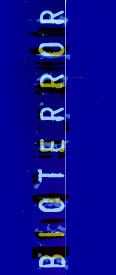|

|

|
|
|
 An anthrax-tainted letter, while able to kill and
spread terror, is not the most dangerous anthrax
weapon.
An anthrax-tainted letter, while able to kill and
spread terror, is not the most dangerous anthrax
weapon.
|
Agents of Bioterror
Anthrax
incubation period |
symptoms |
how it would spread |
treatment |
vaccine
Anthrax gets its name from the Greek word for coal,
anthrakis, because the skin form of the disease is
characterized by lesions that turn jet-black. The three
forms of anthrax disease (skin or cutaneous, inhalation, and
gastrointestinal) are all caused by the same bacterium,
Bacillus anthracis.
When sprayed as a fine aerosol mist, anthrax could be a
weapon of mass destruction. An odorless, invisible cloud of
anthrax could trigger thousands of cases of inhalation
anthrax, the most deadly form of the disease. Bioweapons
programs in the U.S., the Soviet Union, and Iraq mastered
the ability to aerosolize anthrax.
Making a lethal anthrax aerosol requires access to advanced
biotechnology, which some experts believe is beyond the
capability of most terrorists. However, groups with
substantial funding and expertise could acquire the needed
materials. Aum Shinrikyo, the cult infamous for releasing
sarin gas in the Tokyo subway, tried several times to
disperse aerosols of anthrax. It's unclear why the attacks
failed to produce illness.
In the fall of 2001, several deadly anthrax terrorist
attacks took place in the U.S. All told, five people died
and another 18 became infected, most from being in the
vicinity of anthrax-laced letters, but at least two from
completely unknown means. Experts identified the type of
anthrax used in the attacks as the so-called Ames strain,
which was long thought to have originated in Ames, Iowa.
Then, in January 2002, investigators discovered a clerical
error that revealed that the strain's origin was not Iowa
but Texas, where the bacterial strain turned up in a dead
cow in 1981. Authorities are still searching for the
perpetrator of the attacks.
Incubation period before symptoms
12 hours - 5 days
Symptoms
Cutaneous:
-
Skin infections begin as itchy bumps resembling insect
bites, then develop into lesions about half an inch to a
little over an inch in diameter. Lesions become covered
by black scabs.
- swollen lymph nodes
Inhalation:
- fever, chills, headache, nausea, vomiting
- fluid in lungs, severe breathing difficulty
- shock and respiratory failure
Gastrointestinal:
- nausea, loss of appetite, vomiting, fever
-
abdominal pain, severe diarrhea, abdominal bleeding
How it would be spread
Letters with anthrax powder will cause only isolated cases
of disease, relatively few in number. Poisoning of food is
difficult to achieve with anthrax and is not considered
likely. Aerosol spraying is the gravest threat. Anthrax
diseases are not contagious.
Treatment
A variety of antibiotics can treat all three forms of the
disease. Inhalation anthrax, however, progresses so quickly
that, once symptoms are clear, it may be too late for drugs
to prevent death.
Vaccine
The vaccine for anthrax used by the U.S. military is not
currently available to the general public. It is given in a
series of six shots over 18 months. Annual booster
injections are recommended.
Chart of the 8 agents
Photo: Corbis Images
History of Biowarfare
|
Future Germ Defenses
Interviews with Biowarriors
|
Global Guide to Bioweapons
|
Making Vaccines
Resources
|
Teacher's Guide
|
Transcript
|
Site Map
|
Bioterror Home
Search |
Site Map
|
Previously Featured
|
Schedule
|
Feedback |
Teachers |
Shop
Join Us/E-Mail
| About NOVA |
Editor's Picks
|
Watch NOVAs Online
|
To Print
PBS Online |
NOVA Online |
WGBH
©
| Updated February 2002
|
|
|
|